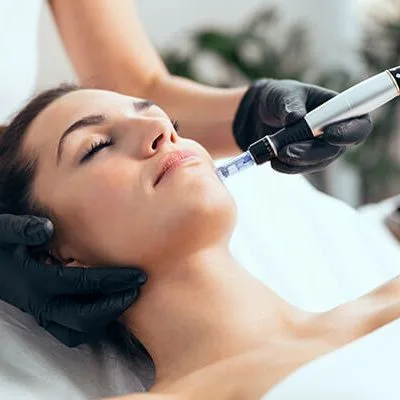Microneedling, also known as collagen induction therapy, is a minimally invasive skin rejuvenation procedure that uses tiny, sterile needles to create micro-injuries in the skin. These controlled injuries stimulate the body’s natural healing response, encouraging the production of collagen and elastin — two essential proteins responsible for maintaining youthful, firm skin.
This treatment has gained immense popularity globally, especially in regions where skin concerns due to sun exposure and humidity are common. Microneedling In Dubai has become a top choice for individuals looking to improve skin texture, tone, and appearance without aggressive surgery or downtime.
How Microneedling Works on the Skin
Microneedling initiates the skin’s repair process by prompting new collagen and skin tissue growth. The device used in the treatment creates thousands of microscopic punctures, encouraging increased blood circulation and cell regeneration. As the skin heals, it becomes firmer, smoother, and more evenly toned. Depending on the depth and type of microneedling device used (manual rollers, automated pens, or RF-based systems), the treatment can target a wide range of concerns, including fine lines, acne scars, enlarged pores, and even mild stretch marks.
Is Microneedling Safe for All Skin Types?
One of the most common questions asked by individuals considering this treatment is: Does microneedling work on all skin types? The answer is generally yes, but with certain considerations based on skin tone, sensitivity, and existing conditions. Microneedling is effective on Fitzpatrick skin types I through VI, which means it is suitable for people with very fair to very dark skin. However, understanding how each skin type responds to treatment is essential for optimal results and safety.
Microneedling for Fair Skin (Types I-III)
Individuals with fair skin tones often benefit greatly from microneedling. These skin types usually tolerate the treatment well with a minimal risk of pigmentation issues. Improvements in skin texture, reduction in wrinkles, and scar healing are typically more visible and occur faster with fewer complications. Fair skin has a lower risk of post-inflammatory hyperpigmentation (PIH), a common concern in cosmetic procedures. However, sun sensitivity post-treatment remains a concern, and adequate sun protection is crucial.
Microneedling for Medium Skin Tones (Types IV-V)
People with medium-toned skin — common in Middle Eastern, Mediterranean, and South Asian populations — respond well to microneedling but may require a more customized approach. Medium skin tones have a moderate risk of developing PIH if the skin is irritated or over-treated. To reduce the risk, dermatological professionals typically suggest gentler depths and longer intervals between sessions. Pre- and post-treatment skincare protocols are also essential to prevent any unwanted pigmentation.
Microneedling for Dark Skin (Type VI)
Microneedling is one of the safest non-laser treatments for individuals with darker skin. Unlike certain lasers or chemical peels, which can lead to hypopigmentation or PIH in darker tones, microneedling avoids heat-based technology, significantly minimizing the risk of pigment alteration. Still, professional evaluation is essential to ensure correct needle depth and treatment settings. Post-care hydration and barrier repair are key to healthy healing in darker skin types.
Skin Conditions That Respond Well to Microneedling
Microneedling can treat a variety of dermatological concerns across all skin types. Some of the most common issues that benefit from microneedling include:
Acne Scars
Microneedling helps reduce the appearance of acne scars by breaking down fibrous tissue and encouraging collagen remodeling. This process smooths the surface of the skin, making scars less visible.
Hyperpigmentation
Although it may seem counterintuitive, microneedling can actually help correct uneven pigmentation — especially when used in combination with brightening serums. However, the risk of PIH must be carefully managed in darker skin tones.
Fine Lines and Wrinkles
As skin ages, collagen production decreases. Microneedling stimulates new collagen and elastin formation, reducing fine lines and promoting firmer skin across all skin types.
Stretch Marks
Microneedling may also help improve the appearance of stretch marks by stimulating tissue repair and enhancing skin elasticity, especially when paired with topical treatments like hyaluronic acid or peptides.
Enlarged Pores
By boosting collagen around the pore walls, microneedling can tighten the skin and make pores appear smaller. This benefit is noticeable across all skin tones when the skin is treated with consistency and care.
Key Benefits of Microneedling for Diverse Skin Types
Non-Thermal Technology
Because microneedling doesn’t rely on heat or light, it reduces the risk of burns, making it safer for medium to darker skin tones.
Customizable Treatment Depths
Different areas of the face and body may require different needle depths. Microneedling allows for personalized treatment, making it adaptable for different skin textures and concerns.
Minimal Downtime
Recovery after microneedling is relatively short and mild compared to more invasive procedures. Most skin types experience redness and slight swelling for 24–72 hours, but healing is typically quick with proper care.
What to Expect Post-Microneedling Across Skin Types
Healing Process
Fair Skin may show redness similar to a sunburn but typically heals within 2–3 days.
Medium Skin might experience slight darkening before peeling or light flaking occurs.
Dark Skin may see temporary dark spots that fade with time and proper post-care.
Final Thoughts
Microneedling is a versatile and safe procedure for most skin tones and types when conducted with precision and care. Its ability to stimulate natural healing and collagen production makes it a preferred option for those seeking long-term skin rejuvenation without the risks associated with more invasive or light-based treatments. While Microneedling continues to gain popularity among people with varying skin tones due to the city’s diverse population, the key to successful outcomes lies in tailored treatments and professional evaluation. When customized to individual skin needs, microneedling offers a safe, effective, and inclusive solution for achieving healthy, glowing skin across all complexions.
